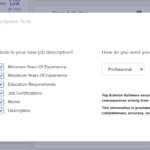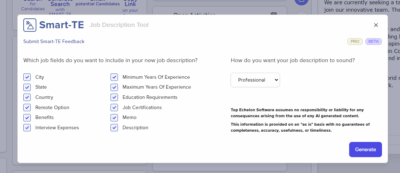(Editor’s note: The information from this article by Top Echelon Recruiting Software has been taken from an Expert Recruiter Coaching Series webinar by Tom Erb of Tallann Resources titled, “Strategies for Securing Job Orders in a Softening Market.” Click HERE to watch the video of that training webinar for free.)
In the current recruitment landscape, professionals are finding themselves in a market that has shifted dramatically from a demand-heavy environment to one where job orders are more challenging to secure. This shift requires recruiters to adapt and employ strategic approaches to not just survive, but thrive.
Drawing on insights from Tom Erb, the President of Tallann Resources and a seasoned expert in the industry, this article provides practical strategies for securing job orders in a softening market.
Job Orders: The Current Market Dynamics
The recruitment industry has undergone significant shifts over the past few years. In 2022, recruiters were overwhelmed with job orders and struggled to keep up with the demand. Today, however, the landscape looks drastically different.
The pendulum has swung back. As a result, many recruiters now find themselves in a position where they must aggressively pursue job orders that were once abundant.
Erb, who has over 30 years of experience in the industry, notes, “The market is in a downturn, but it’s not as bad as it seems. Job openings, though reduced, are still well above pre-pandemic levels. This indicates that while there is a slowdown, the market is still active. The key to navigating this shift lies in adapting our strategies to meet the new challenges.”
While the market is indeed softer, it’s important to recognize that it’s more of a deceleration than a full stop. Erb likens it to driving at 100 miles per hour and then slowing down to 60—not slamming on the brakes, but easing off the gas. This is crucial because it reminds recruiters that while the pace has changed, the opportunity remains.
The Three-Legged Stool of Business Growth
To succeed in this market, recruiters must focus on three critical areas. They are new business development, maximizing existing client relationships, and optimizing order fulfillment.
Erb refers to this as the “three-legged stool of business growth.” If any leg is neglected, the stool becomes unstable, and the business struggles to grow.
Below, we dive further into these three areas:
1. New Business Development
In a softening market, new business development becomes more challenging but also more crucial. Prospects are harder to reach due to remote work and increased competition. This requires recruiters to be more purposeful and consistent in their approach.
“Prospects have become harder to get a hold of,” said Erb. “We have people working remotely and decision-makers are more inundated with sales communications than ever before. It’s harder to stand out.”
To combat this, implementing a structured multi-touch sales process is essential. This process should involve various forms of communication—phone calls, emails, social media outreach, and even traditional methods like snail mail—over an extended period. The goal is to build familiarity and trust with prospects, gradually moving them from cold contacts to warm leads.
According to Erb, decision-makers today are “informational buyers.” They conduct extensive research before engaging with recruiters. This means recruiters must provide proof of their ability to deliver results.
“We need to provide prospects with relevant content that reinforces our value proposition,” Erb said.
This can be achieved through a strong online presence, showcasing client success stories, and leveraging the power of video. Video content, in particular, has become increasingly influential as more prospects prefer consuming information through this medium. Creating short, personalized video introductions can help you stand out in a crowded marketplace.
Erb also suggests using alternative communication methods to reach prospects. “Snail mail is one of the most underutilized tools in today’s digital world,” he said. “While everyone is focused on digital communication, sending a personalized letter can set you apart and catch the attention of a prospect who may be inundated with emails.” This approach is about doing what others aren’t, ensuring that your message is seen.
2. Maximizing Existing Client Relationships
It’s easy to focus solely on acquiring new clients, but maximizing existing relationships can often yield better results, especially in a softening market. “We have to recognize the value in the relationships we already have,” said Erb. “Too often, we neglect these relationships while chasing new business. In reality, existing clients can provide us with more opportunities if we know how to maximize those relationships.”
The first step is to evaluate your current client base and identify those with whom you could do more business. This involves grading both the client company and your relationship with individual contacts within the organization.
Erb introduces the concept of relationship grading, where recruiters assess their connection with key contacts, categorizing them from an “F” to an “A.” An “F” might be a necessary evil, a client who uses your services reluctantly, while an “A” is a trusted advisor relationship, where the client sees you as integral to their success.
“If you’re at an ‘F’ or ‘D’ level with a client, you need to focus on improving that relationship,” said Erb. “On the other hand, if you’re already at a ‘B’ or ‘A’ level, it’s about maintaining that status and looking for ways to deepen the relationship further.” By understanding where you stand with each client, you can tailor your approach to ensure that you’re getting the most out of every relationship.
3. Optimizing Order Fulfillment
The third leg of the stool involves optimizing order fulfillment to ensure that every job order you receive is filled efficiently and effectively. This begins with formalizing processes that may have been done informally in the past.
For example, conducting a formal job intake call, developing an ideal candidate profile, and providing a compensation market analysis can all be presented as value-added services that distinguish your firm from competitors.
“Order fulfillment is not just about filling a position,” said Erb. “It’s about doing it in a way that maximizes value for the client and ensures a successful placement.”
Erb also suggests offering services such as job description reviews, online reputation assessments, and new hire onboarding recommendations as part of the process. “These are things we often do informally,” he said. “But by formalizing them and communicating their value to the client, we can enhance our service and build stronger relationships.”
In addition, Erb advocates for a consultative approach to recruiting. “When we approach recruiting as a consulting engagement, we add value that goes beyond just finding candidates,” he said.
This approach involves formalizing every step of the process, from the initial job intake call to the final onboarding of the candidate. “By treating each search as a consulting project, we not only increase the likelihood of a successful placement, but we also reinforce our position as a trusted advisor to the client,” said Erb.
Leveraging Technology for Efficiency
In today’s fast-paced environment, technology plays an important role in scaling recruitment efforts. Automation tools can help streamline processes, reduce manual tasks, and increase efficiency.
Erb highlights the importance of leveraging technology. “Technology allows us to do more with less,” he said. “By automating routine tasks, we can focus on high-value activities like building relationships and closing deals.”
Several automation tools have become mainstream and affordable, including HubSpot, Zoho CRM, Apollo, and others. These tools allow recruiters to implement structured sales processes, manage client relationships, and optimize order fulfillment more effectively.
Erb emphasized the need for recruiters to stay ahead of technological trends. “The rate at which technology is evolving is astounding,” he said. “We have tools now that allow us to automate complex workflows, giving us more time to focus on what really matters—delivering value to our clients.”
Automation is not just about saving time. It’s also about ensuring consistency and reliability in your processes.
“When you automate, you remove the human error element,” said Erb. “Tasks get done on time, follow-ups are consistent, and you ensure that nothing falls through the cracks.” This level of consistency is particularly important in a softening market, where every interaction counts.
Overcoming Common Challenges
One of the most common challenges in a softening market is the perception that clients are less willing to engage with recruiters. This perception can lead to reduced activity levels, as recruiters may become discouraged by lower response rates.
However, Erb warns against this mindset. “The biggest mistake I see is recruiters backing off when they should be ramping up,” he said. “When the going gets tough, the tough get going. This is when you need to increase your activity, not decrease it.”
Erb advocates for a proactive approach, advising recruiters to increase their outreach efforts during tough times. “You’ve got to pick up the phone, send that extra email, follow up one more time,” he said. “It’s a numbers game, and the more activity you generate, the more opportunities you create.”
Another challenge is dealing with HR departments that may block hiring managers from engaging with recruiters. In these cases, it’s important to ensure that you are working with decision-makers who have enough influence within the organization to push your services through.
“If you’re hitting a wall with HR, it might be time to shift your focus,” Erb advised. “Try to build relationships with key HR personnel or elevate your conversation to someone with more influence within the organization.”
Finally, email communication has become less effective in recent years due to the proliferation of AI-generated content and general email fatigue. While email should still be part of your overall strategy, it should be supported by other forms of communication.
“Personalized videos, snail mail, and phone calls can help differentiate your outreach and increase the chances of engagement,” he said. “The key is to use a multi-touch approach and reach out through various channels.”
Moving Towards Engaged Searches
In a softening market, it’s also worth considering a shift from contingent searches to engaged or retained searches. Engaged searches, where clients pay a portion of the fee upfront, offer greater security and ensure that you are compensated for your efforts.
“Engaged searches are becoming more popular because they provide a level of commitment from both sides,” Erb said. “When a client pays an engagement fee, they’re more invested in the process and you can prioritize their search with confidence.”
While it may be tempting to take on contingent searches to “get your foot in the door,” engaged searches are generally more sustainable and profitable in the long run. To transition clients from contingent to engaged searches, it’s important to communicate the value of your services clearly.
“Highlight your expertise, the additional services you provide, and the higher success rates associated with engaged searches,” said Erb. “Providing clients with data and case studies that demonstrate the benefits of engaged searches can help them see the value in committing upfront.”
Erb also points out that engaged searches lead to better results for both the recruiter and the client. “With engaged searches, you’re not competing with other recruiters,” he said. “You’re focused on delivering the best candidates, and the client knows they have your full attention. It’s a win-win.”
Job Orders: The Final Word
Securing job orders in a softening market requires a strategic approach that focuses on new business development, maximizing existing client relationships, and optimizing order fulfillment. By implementing a structured multi-touch sales process, leveraging technology, and building deeper relationships with clients, recruiters can navigate the challenges of a downturn and continue to thrive.
“Consistency and persistence are key,” said Erb. “Stay proactive, increase your activity levels, and continuously refine your approach. The market may have softened, but opportunities are still out there. Those who adapt and innovate will be the ones who come out on top.”
In a world where the only constant is change, these strategies provide a roadmap for success, even in the most challenging of market conditions. By embracing these approaches, recruiters can not only survive a potential downturn, but emerge stronger and more resilient.
Job Orders and Top Echelon Software
In a softening market, where job orders become increasingly challenging to secure, recruiters need tools that streamline business development and enhance efficiency. Top Echelon’s recruitment software offers a comprehensive solution designed to help recruiters thrive even in difficult economic conditions.
One of the key strengths of Top Echelon’s software is its ability to support multi-touch business development strategies. The software’s powerful recruiting CRM capabilities allow recruiters to track and manage relationships with prospects, ensuring consistent follow-ups and engagement across multiple channels. By organizing contact information, automating outreach, and setting reminders for follow-up actions, recruiters can maintain a steady pipeline of potential clients, even when market conditions are tough.
In addition, Top Echelon’s software includes features that enable recruiters to showcase their value proposition effectively. Customizable email templates, integrated with data-driven insights, allow recruiters to craft compelling messages that resonate with potential clients. This helps in demonstrating the unique value they bring to the table. This is critical for securing job orders in a competitive environment.
The software’s reporting tools also play a critical role in business development. Recruiters can generate detailed reports on their activities, helping them identify which strategies are working and where adjustments are needed. This data-driven approach ensures that recruiters can optimize their efforts, focusing on the most promising opportunities.
In a market where every opportunity counts, Top Echelon’s recruiter software provides the tools necessary to enhance business development and secure job orders, positioning recruiters for success even in challenging times.
Get a Free Trial and/or Request a Live Demo
Ready to take the next step? You can try Top Echelon Software to see how it can help you and your recruiting agency.
First, you can get free recruitment software from Top Echelon for 15 days as part of your trial period.
In addition, you can request a recruitment software demo of our applicant tracking system for agency recruiters and search consultants.
And last, but certainly not least, check out our recruiting software pricing page for more information. Top Echelon is as affordable as it is powerful!
What are you waiting for? Get started today!









